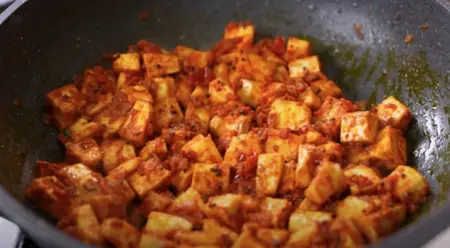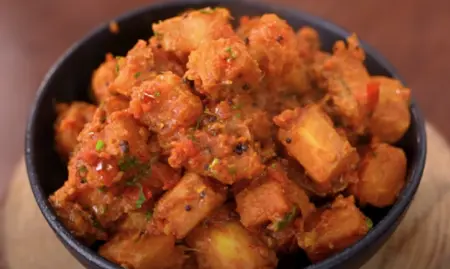
Kache Kele Ki Sabji

45mins

5

05mins
Introduction:
I still remember the first time I came across Kache Kele Ki Sabji. It was during one of my visits to my grandmother’s house in the village. She made this dish with such simplicity, yet the flavors were absolutely mind-blowing. I was fascinated by how a humble ingredient like raw banana could turn into something so delicious. This dish always takes me back to those cozy afternoons in her kitchen, where she'd teach me the art of bringing out the best from basic ingredients.
Kache Kele Ki Sabji holds a special place in my heart because of its versatility and the comfort it brings. Whether you’re looking for a quick side dish or a flavorful main, this sabji does the trick every time. Over the years, I’ve made small tweaks to the recipe, but the core remains the same—simple ingredients with bold flavors.
Ingredients of Kache Kele Ki Sabji
- 4-5 raw bananas
- 2 tbsp oil
- 1 tsp mustard seeds
- 2 medium onions, chopped
- 2 tsp ginger-garlic paste
- 1 tsp green chili, chopped
- 2 medium tomatoes, chopped
- 1 tsp salt (adjust to taste)
- ½ tsp turmeric powder
- 1 tsp coriander powder
- 1 tsp red chili powder
- 4-5 banana dices
- Water as required
- 1 tbsp coriander, chopped (for garnish)
Instructions of Kache Kele Ki Sabji
Step 1: Prepare the Bananas
Peel the raw bananas and cut them into small cubes. To prevent the bananas from turning black, soak them in water while preparing other ingredients.
Step 2: Heat Oil and Temper with Mustard Seeds
Heat 2 tbsp of oil in a pan on medium heat. Once hot, add 1 tsp of mustard seeds and let them crackle for about 30 seconds. This will release their aroma and flavor.
Step 3: Sauté the Onions
Add the chopped onions to the pan and sauté them until they turn golden brown. Stir frequently to avoid burning and allow the onions to caramelize for a rich, deep flavor.
Step 4: Add Ginger-Garlic Paste and Chillies
Add 2 tsp of ginger-garlic paste and sauté for a minute until the raw smell disappears. Next, toss in the chopped green chilies for a subtle kick of heat.
Step 5: Cook the Tomatoes and Add Spices
Add the chopped tomatoes and cook until they soften and become a thick paste. Then, mix in salt, turmeric powder, coriander powder, and red chili powder. Stir well to blend the spices with the tomato-onion mixture.

Step 6: Cook the Bananas and Finish the Dish
Add the diced raw bananas to the spiced tomato mixture. Stir well so that each piece is coated evenly with the masala. Add a little water to prevent sticking, then cover the pan and cook on low heat until the bananas are tender but not mushy (about 10 minutes). Once cooked, uncover and let any excess moisture evaporate, ensuring the masala is thick and clings to the bananas.

Sub-step 1: Garnish the sabji with freshly chopped coriander leaves for a burst of freshness.
Sub-step 2: Serve hot with chapati, puri, or steamed rice for a delicious and wholesome meal.

About the Recipe:
Kache Kele Ki Sabji is a simple yet flavorful dish made from raw bananas, commonly cooked in Indian households. Raw bananas, known for their starchy texture, are the perfect substitute for potatoes, offering a mildly sweet taste that absorbs spices beautifully. This sabji is often paired with hot phulkas or parathas, making it a wholesome meal that is filling and nutritious.
One of the great things about this recipe is how quick and easy it is to prepare, especially on busy days when you want something hearty but don't have much time. The use of everyday spices like turmeric, cumin, and coriander adds depth to the dish, while the raw banana absorbs the flavors perfectly. Whether you are making it for a weeknight dinner or serving it to guests, this sabji is always a hit.
Cooking Tips:
- Make sure to peel the raw bananas properly before cutting them into cubes. The peel can be quite tough, and if not removed entirely, it may affect the texture of the dish.
- To prevent the bananas from turning black after cutting, soak them in water mixed with a bit of turmeric. This will also add a hint of color to the dish.
- Don’t overcook the raw bananas, as they can become mushy. Keep an eye on them while cooking to maintain a firm texture.
- If you want to add more depth of flavor, you can toss the cooked banana cubes in a tadka of mustard seeds and curry leaves for that extra zing.
- For a tangy twist, squeeze a bit of lemon juice or sprinkle some amchur (dry mango powder) before serving.
Pairing Guide:
Kache Kele Ki Sabji pairs beautifully with a variety of Indian breads like phulkas, parathas, or even puris. You can also serve it alongside steamed rice and dal for a comforting, wholesome meal. For a refreshing side, pair it with cucumber raita or plain yogurt to balance the heat from the spices. If you're in the mood for something light, this sabji can be a great accompaniment to a simple salad of sliced onions, tomatoes, and a squeeze of lemon. A cool glass of buttermilk or lassi also makes for an excellent pairing, helping to cleanse the palate between bites.
Frequently Asked Questions:
-
What is the best way to prepare raw bananas for Kache Kele Ki Sabji?
The best way to prepare raw bananas is to peel them completely and cut them into medium-sized cubes. To prevent discoloration, soak the banana pieces in water mixed with a pinch of turmeric. -
Can I use ripe bananas for this recipe?
No, ripe bananas have a sweet flavor and soft texture that won’t work well for Kache Kele Ki Sabji. Raw bananas are firm and starchy, making them ideal for this dish. -
Is Kache Kele Ki Sabji healthy?
Yes, raw bananas are a good source of dietary fiber and essential vitamins. When cooked with minimal oil and spices, Kache Kele Ki Sabji makes for a nutritious and balanced meal. -
Can I make this dish ahead of time?
Yes, Kache Kele Ki Sabji can be made ahead of time and stored in the refrigerator for up to two days. Reheat it on the stove or microwave before serving. -
What other vegetables can I add to this sabji?
You can add vegetables like peas or carrots to the sabji to enhance the flavor and texture. However, keep in mind that the raw banana should remain the star ingredient. -
How can I make Kache Kele Ki Sabji more tangy?
You can add a little amchur powder (dry mango powder) or squeeze some lemon juice over the sabji at the end of cooking to give it a tangy twist. -
Can I make this sabji without onions and garlic?
Yes, Kache Kele Ki Sabji can easily be made without onions and garlic. Just increase the amount of cumin and turmeric to maintain the flavor balance. -
What type of oil is best for cooking this dish?
Any neutral-flavored oil like sunflower or vegetable oil works well for Kache Kele Ki Sabji. Mustard oil can also be used if you prefer a stronger, more traditional flavor. -
What is the ideal spice level for this dish?
The spice level can be adjusted to your preference. Traditionally, it has a mild heat, but you can add more green chilies or red chili powder if you prefer it spicier. -
Can I serve Kache Kele Ki Sabji with rice?
Yes, you can serve this sabji with rice, although it’s more commonly paired with Indian breads like phulkas or parathas. If serving with rice, add a side of dal for a complete meal.
